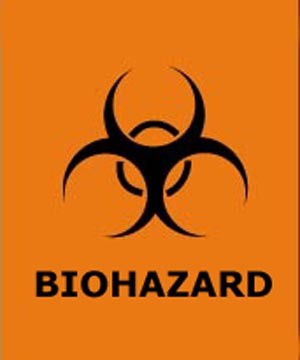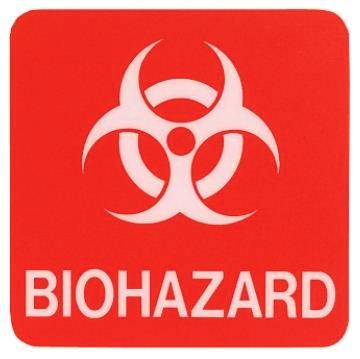The following terms are used in this document. The definitions below are used in the scope of this document but local regulatory definitions override if there is a conflict.
Acquired Immune Deficiency Syndrome (AIDS): A disease of the immune system characterized by increased susceptibility to opportunistic infections. It is caused by a retrovirus that is transmitted chiefly through blood or blood products that enter the body's bloodstream, especially by sexual contact or contaminated hypodermic needles.
Bloodborne Pathogens (BBP): Pathogenic microorganisms present in human blood, tissue, and fluids. Exposure to BBP may result in disease in humans. These pathogens include, but are not limited to, HBV and HIV.
Contaminated: The presence or the reasonably anticipated presence of blood or other potentially infectious materials on an item or surface.
Decontamination: The use of physical or chemical means to remove, inactivate, or destroy BBP on a surface or item to the point where they are no longer capable of transmitting infectious particles and the surface or item is rendered safe for handling, use, or disposal.
Engineering Controls: The elimination or reduction of a hazard by means of engineered machinery or equipment. For BBP, those controls include sharps disposal containers, self-sheathing needles, sharps with engineered sharps injury protections, and needleless systems. These controls isolate or remove the bloodborne pathogens hazard from the workplace.
Employee Exposure: Contact by an individual to a concentration of a hazardous substance or contaminant through inhalation, ingestion, dermal absorption, or injection.
Environmental Protection Agency (EPA): An agency of the federal government of the United States charged with protecting human health and the environment by writing and enforcing laws.
Exposure Incident: An act where blood or other potentially infectious materials makes contact with an employee's eye, mucous membrane, non-intact skin, or through a puncture wound.
Hepatitis A Virus (HAV): A microorganism which primarily causes inflammation of the liver in humans. This virus is the most common hepatitis virus and is found in infected fecal matter.
Hepatitis B Virus (HBV): A microorganism which primarily causes inflammation of the liver in humans. HBV spreads through contact with infected body fluids such as blood, semen, and vaginal fluids.
Hepatitis C Virus (HCV): A microorganism which primarily causes inflammation of the liver in humans and may cause permanent damage such as scarring of the liver or liver cancer. HCV is most commonly spread through sharing needles and exposure to infected blood. Unprotected sexual contact can sometimes spread the virus.
Human Immunodeficiency Virus (HIV): Any of the various strains of retrovirus in the genus Lentivirus that causes AIDS by infecting the body’s immune system.
Needleless Systems: A device that does not use needles for: (1) The collection of bodily fluids or withdrawal of body fluids after initial venous or arterial access is established; (2) The administration of medication or fluids; or (3) Any other procedure involving the potential for occupational exposure to BBP due to percutaneous injuries from contaminated sharps.
Occupational Exposure: Reasonably anticipated skin, eye, mucous membrane, or parenteral contact with blood or other potentially infectious materials that may result from the performance of an employee's duties.
Other Potentially Infectious Materials (OPIM): A material that can be described as one of the following:
The following human body fluids: semen, vaginal secretions, cerebrospinal fluid, synovial fluid, pleural fluid, pericardial fluid, peritoneal fluid, amniotic fluid, saliva in dental procedures, any body fluid that is visibly contaminated with blood, and all body fluids in situations where it is difficult or impossible to differentiate between body fluids.
Any unfixed tissue or organ (other than intact skin) from a human (living or dead).
HIV-containing cell or tissue cultures, organ cultures, and HIV- or HBV-containing culture medium or other solutions.
Blood, organs, or other tissues from experimental animals infected with HIV or HBV.
Physician or Other Licensed Health Care Professional (PLHCP): An individual whose legally permitted scope of practice (i.e., license, registration, or certification) allows him or her to independently provide, or be delegated the responsibility to provide, some or all of the health care services required.
Regulated Waste: A material that meets one of the following descriptions and that must be handled and disposed of as defined in 29 CFR 1910.1030:
Liquid or semi-liquid blood or other potentially infectious materials.
Contaminated items that would release blood or other potentially infectious materials in a liquid or semi-liquid state if compressed.
Items that are caked with dried blood or other potentially infectious materials and are capable of releasing these materials during handling.
Contaminated sharps.
Pathological and microbiological wastes containing blood or OPIM.
Universal Precautions: An approach to infection control. According to the concept of Universal Precautions, all human blood and OPIM are treated as infectious for HIV, HBV, and other BBP.
Work Practice Controls: Operating practices that reduce the likelihood of exposure by altering the manner in which a task is performed (e.g., prohibiting recapping of needles by a two-handed technique).

